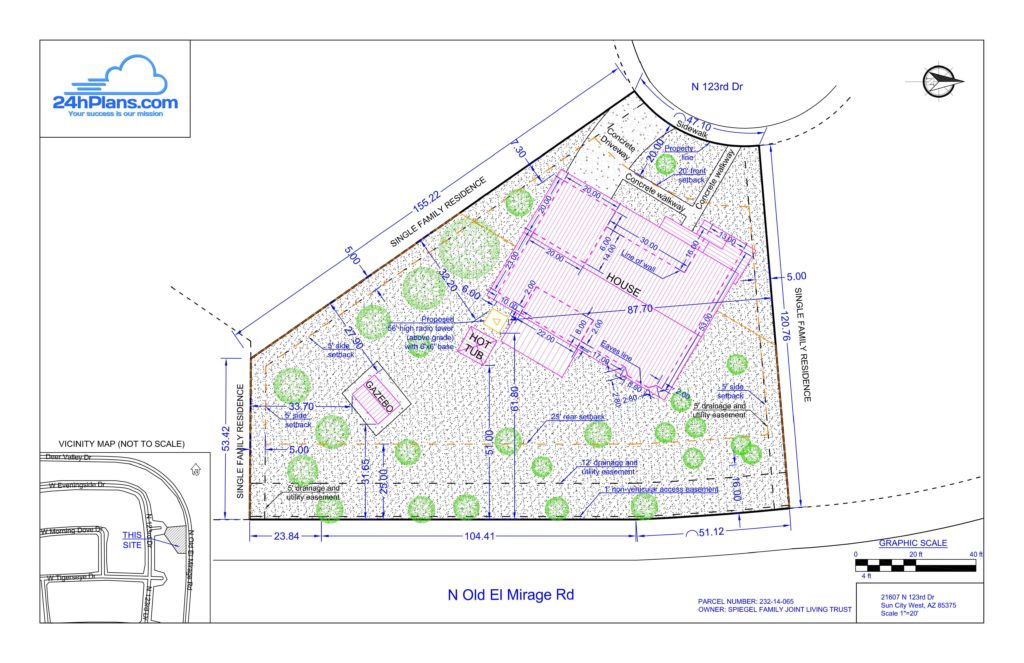There are many reasons to have land surveyed, whether it is property you own or a piece of ground you’re considering buying. This article answers questions about:
- When to have land surveyed
- Preparing for a land survey
- What the survey includes
- Who pays for the survey
- The cost of a land survey and factors that determine cost
- Affordable alternatives to a land survey
The Reasons for a Land Survey
The surveyor has one of two primary tasks in each surveying job:
- Precisely establish a parcel’s legal boundaries when it has not been surveyed before, mapping those boundaries and producing a legal description of the boundaries that determine what ground the parcel entails
- Determine where the boundary lines are on a previously surveyed parcel. For example, the survey might read something like: “Southwest quarter of Northwest quarter (SW ¼ of NW ¼) and East Half of Southeast quarter of Southwest quarter (E½ SE¼ SW¼) of Section four (4), Forest Township, containing ten (10) acres of land, more or less.”
A surveyor uses the information to determine what area constitutes the parcel legally described. The surveyor works to find the metal pins used to mark the corners of a surveyed parcel or establish where those pins should be placed.
Now, why is land surveyed to identify the boundaries? The most common reasons are:
- The land will be bought: Buyers are encouraged to have property surveyed to prevent future disputes about its boundaries, especially when buying a small parcel recently split from a large parcel. If the purchase is being financed, the lender will require a survey to protect its interest in the property.
- The land will be divided: When a large parcel is divided, whether into two parcels or a multi-lot subdivision, a survey shows the legal boundaries of the new, smaller parcels and additional features such as a road or utility easement into the property.
- The land will be developed: If you own vacant land and intend to improve it in any way including building on it, the land might have to be surveyed to establish its boundaries, so that any improvement meets setback requirements. A setback refers to how far off the boundary or lot line the improvement must be. For example, a county might require that homes be built at least 20 feet off the property line (a 20-foot setback).
- Improvements will be made to previously developed land: If you’re adding structures such as a master suite, garage, deck or fence to an existing home, a survey will demonstrate that the new additions meet setback requirements.
- Boundaries are in dispute: Disputes arise over many issues such as whether a fence is on the wrong side of the property line or a deck doesn’t meet setback requirements. These disputes are settled using a legal survey of the property.
Preparing for a Land Survey
Your goal is to make sure the survey is done easily and accurately. These tips will reduce the difficulty and time, and hence the cost, required to complete a survey:
- Provide the surveyor with legal documents you have such as a previous survey or a title deed showing the property’s legal description or that of the larger parcel being split
- Provide a plat map of the land, especially useful for large parcels
- Clear debris from lot lines or where lines are to be established, with one note of caution: Don’t cut down trees or clear landscape plants that might be on an adjoining parcel
- Meet the surveyor at the property to answer any questions you can
- Locate and mark with marking paint and/or wood stakes the existing boundary pins (sometimes called monuments), a good option for those who have a metal detector or can borrow one without cost
What a Land Survey Includes
All completed land surveys include a scale drawing of the parcel or parcels with precise measurements. When the parcel has been improved, the survey also shows the location of a home, deck, garage, driveway, sidewalk, swimming pool, river, pond and other permanent features.
Advanced land surveys can also show things such as:
- The location of large trees or stands of trees
- Fences
- Topographical contours demonstrating varying heights and how rainwater drains from the property
- The location of underground storage tanks
- Perc test holes where land is or is not suitable for a drain field
Who Pays for a Land Survey?
The property owner pays for the survey if selling, dividing or improving the land or if the survey is done to give the owner a clear description of the parcel they own.
When property lines are in question, the party bringing the dispute pays for the survey. However, if the disputing party is correct, the owner might be made to pay for the survey in a civil lawsuit.
Land Survey Cost
How much does a land survey cost? The range is $300 to $1,200 or more.
The complexity of the survey will determine the exact cost:
- Surveying to insure the accuracy of a previous survey costs the least
- If just the field work of marking corners is needed, the survey will cost less than if a drawing is also required
- Single parcels cost less than surveying a large parcel divided into multiple smaller parcels; The more divisions, the higher the land survey cost will be
- The more corners a single parcel has, the higher the cost will be
- When boundary lines and corners are hard to access due to dense woods or water, the land survey price is higher
- The more detailed the survey is (structures, topography, wooded areas), the higher the cost
Affordable Alternatives to a Survey
Getting a survey might be avoidable. If the parcel has been surveyed, is not being split and you simply want to know its parameters, it might be possible to find and mark the pins/monuments as suggested using a metal detector.
A Plot Plan vs. a Land Survey
When you’re improving an existing lot, a site plan, often called a plot plan in many communities, might be all the building department requires. A plot plan is a drawing showing existing structures and other manmade features, if any, and proposed improvements to the land. Site plans are accepted in many counties to verify that the improvements will meet development code requirements for projects such as:
- Garages
- Sheds
- Decks
- Driveways
- Sidewalks
- Gazebos
- Fences
- Retaining walls
- Pools
- Fountains
- Ponds
Specifics vary by county, so call your county building department to determine whether a site plan or plot plan will be sufficient for your land development project.
Note: Here’s how we can help: 24hplans has team of highly-trained, professional architects and drafters who can prepare any kind of site plan in the shortest amount of time possible, so that you can easily obtain that building permit and get on with your project. Use the promotion code: 24hplans-20off to get a 20% discount off any package. — Please note this is a limited time offer, exclusive to the readers of our blog. This offer is not being advertised anywhere else.




I am planning for an addition. I have a architecture drawing but the town is asking for a Plot Plan. I do not know to what level of detail they need it. Can you work with the town and prepare a plot plan that conforms to the town requirement?
Hi Krish,
Yes, so any time you request a site plan from us, you will get a site plan that adheres to the local requirements. We always work with you to deliver exactly what you need. Simply request a Medium Design Site Plan here: https://www.24hplans.com/site-plans-permits/ and provide comments on some of the specifics. Use the promotion code: 24hplans-20off to get a 20% discount off any plot plan package.
I need to have a survey/site/plot/grading plan done and I am unsure if you are able to do this. I am in Orlando FL. Do you do the site plans for Florida?
Hi Tammy,
Yes, we draft site plans for every city and town in the US!
Simply request a Site Plan here: https://www.24hplans.com/site-plans-permits/ and provide comments on some of the specifics. Use the promotion code: 24hplans-20off to get a 20% discount off any plot plan package.
I’m trying to get an above ground swimming pool and have no plot plan on file to obtain the permit. Any suggestions on what to do? Thank you!
Hi Karen,
That’s what we are here for! Our team of drafters can produce a simple site plan to help you get the permit from the town-hall.
Note: Here’s how we can help: 24hplans has team of highly-trained, professional architects and drafters who can prepare any kind of site plan in the shortest amount of time possible, so that you can easily obtain that building permit and get on with your project. Use the promotion code: 24hplans-20off to get a 20% discount off any package. — Please note this is a limited time offer, exclusive to the readers of our blog. This offer is not being advertised anywhere else.
I didn’t know that it could be good to get this survey if you if the land could be divided, like a multi-lot subdivision. It sounds like it could be good to get this well in advance.
It’s interesting that you talked about getting a survey before adding a garage to your home. I have been thinking about adding a garage and an extra room onto my house. I can see how it would be nice to have a survey done first. That way, I won’t have to worry about breaking any boundary laws I’m unaware of.